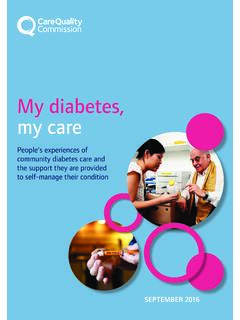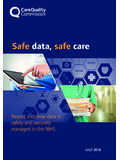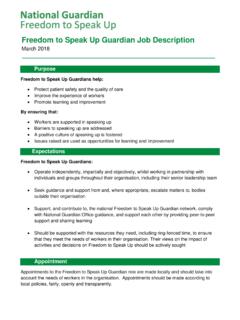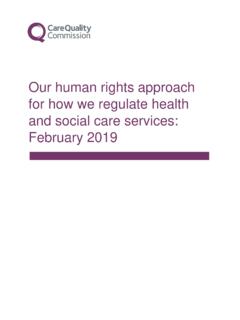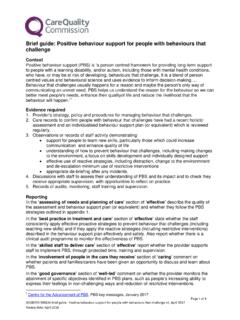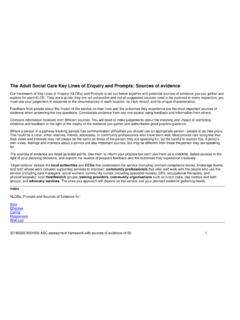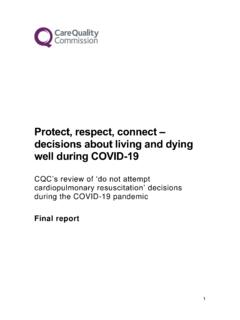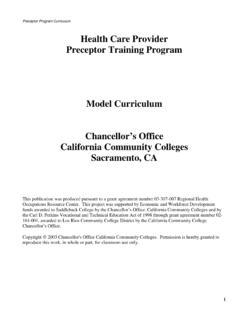Transcription of Opening the door to change - Care Quality Commission
1 Opening the door to changeNHS safety culture and the need for transformationDECEMBER 2018 Opening THE DOOR TO CHANGEb Opening THE DOOR TO CHANGEA bout the Care Quality Commission Our purposeThe Care Quality Commission is the independent regulator of health and adult social care in England. We make sure that health and social care services provide people with safe, effective, compassionate, high- Quality care and we encourage care services to roleWe register health and adult social care monitor and inspect services to see whether they are safe, effective, caring, responsive and well-led, and we publish what we find, including Quality use our legal powers to take action where we identify poor speak independently, publishing regional and national views of the major Quality issues in health and social care.
2 And encouraging improvement by highlighting good valuesExcellence being a high-performing organisationCaring treating everyone with dignity and respectIntegrity doing the right thingTeamwork learning from each other to be the best we canNHS SAFETY CULTURE AND THE NEED FOR TRANSFORMATION1 SAFE DATA, SAFE CAREOPENING THE DOOR TO CHANGEC ontentsCLAIRE S STORY ..2 FOREWORD ..3 SUMMARY ..5 INTRODUCTION ..9 PATIENT SAFETY AND THE CHALLENGES FOR NHS TRUSTS ..121. Workload and prioritisation ..142. Lack of standard processes ..163. Leadership and governance ..18 Summary ..22 PATIENT SAFETY IN THE WIDER HEALTHCARE SYSTEM ..231. Communication and coordination of messaging ..252. Support from national bodies ..253. Support from clinical commissioning groups.
3 264. Sharing learning nationally ..275. Trust patient safety systems and cultures ..286. Involving patients ..30 Summary ..32 EDUCATION AND TRAINING FOR STAFF ON SAFETY SYSTEMS AND PROCESSES ..331. National patient safety education ..352. Local and post-qualification education ..373. Leadership in patient safety education ..40 Summary ..42 CONCLUSION ..43 Recommendations ..45 REFERENCES ..48 APPENDIX A: NEVER EVENTS LIST ..50 APPENDIX B: HOW WE CARRIED OUT THE REVIEW ..51 APPENDIX C: ORGANISATIONS INVOLVED IN THE THEMATIC REVIEW ..54 Opening THE DOOR TO CHANGE2 ClAIRE S STORyClaire s storyClaire (not her real name) describes the effect of experiencing a wrong-site surgery. I was experiencing a tremendous amount of pain due to sciatica, and had a procedure to relieve this.
4 It resulted in the surgeon injecting the wrong side. This was recognised immediately and as I was awake during the procedure he was able to ask me if he could do the right side, so it was rectified straight away. It was classed as a Never Event as it was a wrong-site surgery .* Looking back, I can see the circumstances that led to the incident. I noticed that when people were doing checklists before the procedure they were interrupted quite a lot. I had one checklist with a nurse who was interrupted by an anaesthetist, who was then interrupted by a surgeon. I offered to give feedback to the and I was invited to have a chat. Everyone listened and took a lot of notes. The manager of orthopaedics was very adversarial and wouldn t accept any of it there was clearly an issue between them and the rest of the surgical team, and it was really uncomfortable.
5 Some of the things they said also indicated that they had productivity targets to meet as a priority. One of the obvious things that was picked up during the investigation was volume they were getting too many cases through the door, all with multiple appointments. The system felt fractured. When you have a poor experience, the amount of trust you have in the system declines you ask whether you want to expose yourself to that again. The incident didn t impact my life personally that much I was just pleased that the problem was solved and neuropathic pain was gone. [However,] the clinical governance lead was very attentive they seemed committed to safety and stopping the poor experience, and that it was the circumstances that caused the incident rather than the person.
6 Following the incident, the trust moved this sort of procedure to day surgery, so the second time I went in, it was a brilliant experience. The department felt more coordinated, less busy, staff seemed happier, and it was a smoother experience. Personally, I feel culture is just one part of the issue. It comes back to having a system of penalising staff. The assumption is that there s been wrongdoing rather than mistakes and puts blame on frontline staff, rather than further up the chain. *Note: the Never Event status of the type of incident used in this example is temporarily suspended, as the supporting clinical guidance for preventing such incidents is currently under review. The revised classification details will be reinstated in due SAFETy CUlTURE AND THE NEED FOR TRANSFORMATION3 Foreword There has been much focus on the safety of NHS care over recent years and there is unquestionably a strong commitment across the service to make the care of patients as safe as possible.
7 Our inspections of NHS trusts have identified safety culture as a key concern and this study of the reasons for the recurrence of Never Events shows us that while the commitment to safety is indeed strong, trusts remain in the dark when it comes to up-to-date understanding of the principles of safety both within and outside the NHS, and have limited capacity to keep staff in touch with current best practice. Without specific patient safety expertise in each trust, the risk is that organisations will not have the necessary tools and knowledge to change the culture of safety in the NHS. Never Events are patient safety incidents. They are only a very small proportion of the approximately two million reported patient safety incidents and approximately 21,500 serious incidents reported in 2017/18 in England s NHS.
8 What sets Never Events apart is that they are believed to be wholly preventable by the implementation of the appropriate safety protocols. Despite this preventability, the number of Never Events has not fallen. About 500 times each year we are not preventing the preventable. That means that around 500 patients are suffering unnecessary harm. This failure to reduce the number of Never Events is sending us an important occurrence of a Never Event is thought to tell us something important about the patient safety processes in the service where it happens. There is undoubtedly some truth in this, but as we have carried out this review it has become increasingly clear to us that our failure to reduce the toll of Never Events tells us something fundamental about the safety culture of our health care.
9 We brought together healthcare staff with experience of managing safety issues and safety experts from other safety critical industries. We were struck by how differently health care thinks about safety compared with other industries. The other safety critical industries speak of their work as high risk and this informs everything they do. Safety alerts are implemented effectively and consistently; an understanding of team dynamics, situational awareness, and human factors and ergonomics are central to how they work. Safety protocols are followed without question. Staff are expected to raise any concerns about safety and do so as a matter of course. There is no hesitation in stopping operational processes if safety is thought to be in any way compromised.
10 Opening THE DOOR TO CHANGE4 FOREwORDS afety training is never regarded as optional. They stressed to us that errors were inevitable and that everything they do is planned with this in care, which in statistical terms is higher risk than any of the industries we consulted, in contrast took the view that safety was the norm and things only went wrong exceptionally. Staff are not expected to make errors. This leads to a search for quick fixes and technical solutions, when Never Events occur. Our analysis showed that only 4% of Never Events are amenable to this approach, the overwhelming majority require human factors based solutions. There is a contradiction between how health care culturally thinks about patient safety and the experience of individual members of staff.
